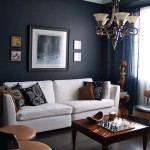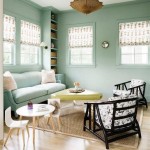Living Room Black and White Decor: A Timeless and Versatile Design Choice
The living room, often considered the heart of a home, serves as a space for relaxation, entertainment, and social gatherings. Its design plays a crucial role in establishing the overall atmosphere and reflecting the homeowner's personal style. Among the myriad of design choices available, a black and white decor scheme remains a persistently popular option, lauded for its timeless appeal, versatility, and ability to create a sophisticated and visually striking environment.
The enduring popularity of black and white decor stems from its inherent simplicity and adaptability. It transcends fleeting trends, providing a neutral canvas upon which to build a personalized space. This color scheme allows for the easy incorporation of diverse textures, patterns, and accent colors, enabling homeowners to tailor the living room to their specific preferences and create a unique and inviting atmosphere.
This article will explore the key aspects of incorporating black and white decor into a living room, examining the benefits of this design approach, providing practical considerations for implementation, and highlighting various stylistic interpretations.
The Advantages of a Black and White Living Room
The implementation of a black and white color scheme in a living room offers several distinct advantages. These extend beyond mere aesthetics, impacting the perceived size of the space, influencing the overall mood, and simplifying the process of incorporating personal touches.
Firstly, a black and white palette can visually expand a smaller living room. Utilizing white as the dominant color reflects light, creating a sense of spaciousness and airiness. Strategically placed black accents, such as furniture legs, picture frames, or throw pillows, provide visual anchors without overwhelming the room. Conversely, in larger living rooms, black can be used more liberally to create a sense of intimacy and definition. A black accent wall, for example, can effectively reduce the perceived size of a room and establish a focal point.
Secondly, the inherent neutrality of black and white allows for greater flexibility in terms of furniture and accessory selection. Virtually any color can be incorporated as an accent without clashing, providing homeowners with the freedom to experiment with different styles and trends. A pop of color, such as a vibrant rug or a collection of colorful cushions, can inject personality and energy into the space while maintaining the overall sophistication of the black and white foundation.
Thirdly, black and white decor promotes a sense of visual clarity and sophistication. The absence of excessive color can create a calming and uncluttered environment, ideal for relaxation and unwinding. The stark contrast between black and white also draws attention to architectural details and design elements, allowing for a more focused appreciation of the space's inherent qualities.
Finally, the minimalist nature of black and white simplifies the decorating process. The color palette inherently reduces the risk of overwhelming the space with too many competing hues. This simplifies the selection of furniture, artwork, and accessories, allowing homeowners to focus on quality, texture, and overall design coherence.
Practical Considerations for Implementation
While the concept of a black and white living room may appear straightforward, successful implementation requires careful planning and attention to detail. Several practical considerations must be addressed to ensure a balanced and visually appealing outcome.
The first and foremost consideration is determining the desired ratio of black and white. A predominantly white room with black accents will feel significantly different from a room with a more balanced distribution of the two colors. The choice depends largely on the size of the room, the amount of natural light available, and the desired mood. Smaller rooms with limited natural light typically benefit from a higher proportion of white, while larger, well-lit rooms can comfortably accommodate a more generous use of black.
Lighting plays a critical role in a black and white living room. Adequate lighting is essential to prevent the space from feeling dull or sterile. Consider incorporating a variety of light sources, including ambient lighting (such as chandeliers or recessed lighting), task lighting (such as floor lamps or table lamps), and accent lighting (such as spotlights or sconces). The type of light bulb used is also important; warm-toned bulbs can soften the starkness of the black and white palette, while cool-toned bulbs can enhance the modern and minimalist aesthetic.
Texture is another crucial element. A purely black and white space can feel flat and uninteresting if it lacks textural variation. Incorporate a variety of textures through fabrics, materials, and accessories. Consider using plush rugs, linen curtains, leather furniture, and woven baskets to add depth and visual interest. Combining smooth and rough textures, such as a glossy black coffee table paired with a textured white throw blanket, can create a dynamic and engaging space.
Pattern can also be used effectively in a black and white living room. Geometric patterns, such as stripes, chevrons, or polka dots, can add visual energy and create a focal point. Floral patterns can introduce a touch of softness and femininity. Consider using patterned wallpaper, rugs, or cushions to incorporate pattern without overwhelming the space. When using patterns, it is important to maintain a consistent scale and style to ensure a cohesive look.
Finally, consider the architectural style of the living room. A black and white palette can be adapted to suit a variety of styles, from modern and minimalist to traditional and bohemian. In a modern living room, clean lines and geometric shapes will complement the starkness of the color scheme. In a traditional living room, ornate details and classic patterns can add a touch of elegance. In a bohemian living room, layered textures and eclectic accessories can create a more relaxed and inviting atmosphere.
Stylistic Interpretations of Black and White Decor
The versatility of black and white decor allows for a wide range of stylistic interpretations. The same color palette can be used to create drastically different atmospheres, depending on the specific design choices made.
A minimalist black and white living room emphasizes simplicity and functionality. Furniture is typically sleek and streamlined, with minimal ornamentation. Accessories are carefully curated and kept to a minimum. The focus is on creating a clean and uncluttered space that promotes a sense of calm and tranquility. In this style, storage solutions are paramount, and clutter is actively avoided.
A modern black and white living room incorporates bold geometric shapes and contemporary materials. Furniture may feature chrome or glass accents, and artwork often consists of abstract or graphic designs. The overall aesthetic is one of sophistication and cutting-edge style. This style often incorporates unexpected elements, such as bold lighting fixtures or statement art pieces.
A traditional black and white living room exudes elegance and timelessness. Furniture is typically upholstered in luxurious fabrics, such as velvet or silk, and features classic silhouettes. Accessories include antique mirrors, ornate picture frames, and crystal chandeliers. The overall atmosphere is one of warmth and refinement. This style often utilizes traditional patterns, such as damask or toile, to add a touch of historical charm.
A bohemian black and white living room embraces eclecticism and individuality. Furniture is often a mix of vintage and contemporary pieces, and accessories are collected from various sources. Layered textures, such as Moroccan rugs, macrame wall hangings, and embroidered cushions, create a cozy and inviting atmosphere. The overall aesthetic is one of relaxed informality and personal expression. This style embraces imperfections and celebrates the unique character of each piece.
A Scandinavian black and white living room prioritizes functionality and natural light. Furniture is typically made from light-colored wood, such as birch or pine, and features simple, clean lines. Textiles are often made from natural fibers, such as cotton or linen. The overall atmosphere is one of warmth, comfort, and understated elegance. This style emphasizes the importance of natural light and often incorporates large windows and minimal window treatments.
Ultimately, the key to creating a successful black and white living room is to embrace personal style and preferences. The color palette provides a neutral foundation upon which to build a space that reflects the homeowner's individual personality and lifestyle. By carefully considering the various design elements and stylistic interpretations, it is possible to create a living room that is both visually stunning and functionally comfortable.

5 Ways To Style A Black And White Living Room Furnitureinstore Blog

21 Best Black White And Grey Living Room Ideas Decor Designs

Before And After Sophisticated Black White Living Room Decorilla Online Interior Design

Change Your Living Room Design With 3 Simple Elements Decoholic

Designing And Decorating With Black White Orange County Register

Home Tour A Warm And Cosy With Black White Decor Your Diy Family

Black And White Living Room Designs

Black White Living Room Decor Ideas Timeless Modern Interior Design Inspiration

17 Stylish Modern Black And White Living Room Ideas Aspect Wall Art

Classic And Chic Black White Living Room Decor Decorilla Online Interior Design








